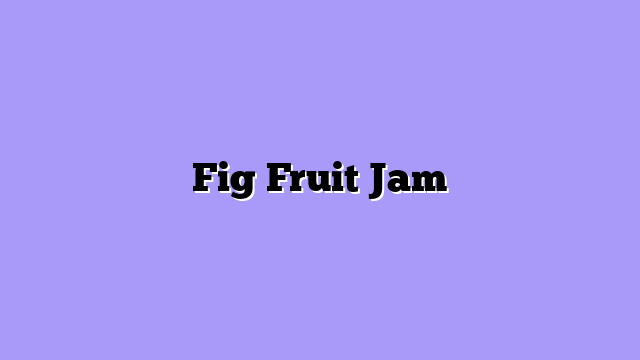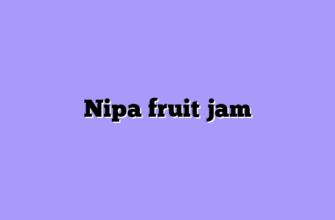There’s a particular moment during late summer that I wait for with childlike anticipation every single year. It’s when my fig trees are so heavy with fruit that branches literally bend under the weight, and I know it’s time to fire up my preserving kitchen.
After years of growing Ficus carica – whether you know them as common figs, anjeer, higos, or simply nature’s candy – I’ve discovered that making fig jam is perhaps the most rewarding way to capture the essence of these remarkable fruits and extend their benefits well beyond their fleeting fresh season.
Let me share with you why fig jam, or fig preserves as some folks call it, has become not just a staple product on my farm but also a nutritional powerhouse that graces my breakfast table year-round. This isn’t just about preserving fruit – it’s about creating something that delivers genuine health benefits while tasting absolutely incredible.
Why Fig Jam Became My Signature Preserve
I’ll be honest with you – I stumbled into jam-making almost by accident. During my first serious fig harvest, I found myself with nearly 80 pounds of ripe fruit and only so many customers who could use fresh figs before they spoiled. These beauties have maybe a two-day window at peak ripeness before they start deteriorating, so I was facing a use-it-or-lose-it situation.

The difference between my homemade fig jam and the stuff you find on supermarket shelves? It’s like comparing a sunset to a photograph of a sunset – sure, they’re related, but one is infinitely more vibrant and alive. When I make jam, I’m using fruit picked at absolute peak ripeness, minimal added sugar (the figs themselves are naturally sweet), and no artificial pectin or preservatives. Just pure, concentrated fig goodness.
The Nutritional Advantages That Survive the Cooking Process
Here’s something that surprised me when I first researched it: many of the beneficial compounds in fresh figs remain remarkably stable through the jam-making process. Yes, you’ll lose some heat-sensitive vitamin C, but the minerals, fiber, and antioxidants? They stick around and actually become more concentrated.
What Makes Fig Jam Nutritionally Special
The fiber content in fig jam is genuinely impressive. Unlike many fruit preserves that are primarily sugar with minimal nutritional value, fig jam maintains significant amounts of both soluble and insoluble fiber from the fruit’s flesh and those tiny edible seeds. A typical two-tablespoon serving of my fig jam contains approximately 2-3 grams of fiber – that’s about 10% of your daily requirement in just a small amount.
The mineral profile is where fig jam really shines compared to other preserves. The potassium, calcium, magnesium, and iron present in fresh figs remain largely intact during cooking. In fact, because you’re concentrating the fruit by removing water, these minerals become more concentrated per serving. I’ve had customers who struggle with leg cramps tell me that regularly eating fig jam has helped reduce their symptoms, likely due to the potassium and magnesium content.
Nutritional Comparison: Fig Jam vs. Other Common Preserves (per 2 tablespoon serving)
| Component | Fig Jam | Strawberry Jam | Grape Jelly | Apricot Jam |
|---|---|---|---|---|
| Calories | 80-100 | 100-110 | 100-110 | 90-100 |
| Fiber | 2-3g | 0.5-1g | 0g | 0.5-1g |
| Calcium | 35-40mg | 5-8mg | 2-4mg | 8-10mg |
| Potassium | 100-120mg | 15-20mg | 10-15mg | 80-90mg |
| Added Sugar | 8-10g | 12-15g | 14-16g | 10-13g |
The polyphenol content in fig jam is another aspect that fascinates me. These powerful antioxidant compounds that give figs their health-promoting properties don’t just survive the cooking process – some research suggests they may become more bioavailable. The darker varieties I use, particularly Black Mission figs, create jams with higher antioxidant activity compared to lighter varieties like Kadota or Adriatic figs.
My Proven Method: Creating the Perfect Fig Jam
After countless batches over the seasons, I’ve refined my process to maximize both flavor and nutritional retention while minimizing added sugars. Here’s the approach that’s never let me down.
Essential Ingredients and Ratios:
The beauty of fig jam lies in its simplicity. You really don’t need much beyond the fruit itself because figs are naturally high in pectin and sugar. My basic ratio is:
- 5 pounds of fresh, ripe figs (any variety works, though I prefer mixing Black Mission with Brown Turkey)
- 1.5 to 2 cups of sugar (far less than traditional jam recipes)
- Juice of 2 lemons (about 1/4 cup)
- Optional: vanilla bean, cinnamon stick, or fresh herbs like rosemary or thyme
Notice how much lower my sugar content is compared to traditional recipes? Most commercial jams use a 1:1 fruit-to-sugar ratio, which I find completely unnecessary with figs. Their natural sweetness means you can cut sugar dramatically while still achieving proper preservation and fantastic flavor.
Step-by-Step Process for Maximum Quality:
- Select and prepare fruit carefully – Use figs that are ripe but not overripe; remove stems and quarter the fruit (no need to peel, the skin contains valuable nutrients and fiber)
- Macerate the fruit – Combine figs with sugar and lemon juice, let sit for 2-4 hours or overnight; this draws out natural juices and begins breaking down the fruit
- Cook low and slow – Use medium-low heat to gently cook the mixture, stirring frequently to prevent scorching; this typically takes 45-60 minutes
- Test for doneness – The jam is ready when it reaches 220°F on a candy thermometer, or when a small amount placed on a chilled plate wrinkles when pushed with your finger
- Can properly for shelf stability – Process in sterilized jars using a water bath canner for 10 minutes; this ensures safe, long-term storage without refrigeration
- Age for optimal flavor – While you can eat it immediately, fig jam actually improves with age; the flavors meld and deepen over 2-3 weeks
Pro Tips I’ve Learned the Hard Way:
- Don’t overcook – overcooked fig jam becomes gummy and loses its fresh fig flavor
- Stir frequently toward the end of cooking to prevent burning on the bottom
- If you want chunkier jam, mash some figs with a potato masher rather than blending everything smooth
- Adding a small amount of balsamic vinegar (1-2 tablespoons per batch) creates incredible depth of flavor
- Save your prettiest, most intact figs for the end of cooking – fold them in gently to maintain texture
The Health Benefits That Keep Me Making Batch After Batch
Beyond the obvious advantage of having delicious jam year-round, there are genuine health benefits to incorporating fig jam into your diet regularly. Now, I’m not suggesting you eat it by the jarful – it’s still a concentrated source of natural sugars and calories – but moderate consumption offers some impressive advantages.
Digestive Support That Actually Works
The fiber in fig jam, combined with natural compounds that have a gentle laxative effect, makes it excellent for digestive regularity. I keep a jar in my refrigerator specifically for those mornings when things feel a bit sluggish. A tablespoon on toast or stirred into oatmeal usually does the trick within a few hours.
What’s happening here? The soluble fiber in figs acts as a prebiotic, feeding the beneficial bacteria in your gut. Meanwhile, the insoluble fiber adds bulk and helps move things along. It’s like having a natural digestive aid that happens to taste amazing on a warm biscuit.
Blood Pressure and Heart Health Support
Remember that potassium I mentioned earlier? It’s not just for preventing muscle cramps. Adequate potassium intake is crucial for maintaining healthy blood pressure levels, and most of us don’t get nearly enough. Starting your day with fig jam on whole grain toast gives you a potassium boost along with complex carbohydrates – a combination that supports cardiovascular health.
I had a customer at the farmers’ market who swore by my fig jam as part of his blood pressure management strategy. He’d spread it on his morning oatmeal along with some nuts, and he told me his doctor was pleased with how his numbers had improved. Now, was it solely the fig jam? Probably not – he’d made several lifestyle changes. But it certainly wasn’t hurting, and it made eating healthy something he looked forward to rather than dreaded.
Antioxidant Benefits in Every Spoonful
The concentrated polyphenols and flavonoids in fig jam provide antioxidant protection that helps combat oxidative stress in your body. Think of oxidative stress as wear and tear on your cells – antioxidants are the maintenance crew that keeps everything running smoothly.
Different fig varieties contain different antioxidant profiles. My Black Mission fig jam tests higher in anthocyanins (the compounds that give dark berries their color), while my Kadota fig jam contains more flavonols. I sometimes blend varieties to create what I call my “antioxidant blend” – it’s not just marketing speak, there’s actual science behind combining different fig types.
Culinary Versatility: Beyond the Toast
One of the reasons fig jam has become such a staple product for my farm is its incredible versatility in the kitchen. This isn’t just breakfast spread – it’s a legitimate ingredient that can transform dishes from ordinary to extraordinary.
My Favorite Ways to Use Fig Jam:
- Cheese board essential – Pair with sharp cheddar, creamy brie, or tangy goat cheese for flavor combinations that make people’s eyes roll back in their heads
- Glaze for roasted meats – Mix with balsamic vinegar and brush on pork chops or chicken during the last 10 minutes of roasting
- Sandwich secret weapon – Spread on a turkey and brie sandwich for a gourmet lunch that takes 5 minutes to make
- Yogurt enhancer – Swirl into plain Greek yogurt for a breakfast that tastes indulgent but delivers protein and probiotics
- Baking ingredient – Use as a filling for thumbprint cookies or swirl into cheesecake batter
- Salad dressing base – Whisk with olive oil, vinegar, and Dijon mustard for a unique vinaigrette
Creative Applications from My Kitchen:
- Fig jam and prosciutto pizza – spread jam on pizza dough, top with fresh mozzarella and prosciutto, bake until crispy
- Morning power bowl – layer Greek yogurt, granola, fig jam, and fresh fruit for a balanced breakfast
- Charcuterie board centerpiece – serve a small bowl surrounded by nuts, cured meats, and crackers
- Dessert sauce – thin slightly with warm water and drizzle over vanilla ice cream or pound cake
- Marinade base for grilled vegetables – mix with olive oil and herbs, brush on eggplant or zucchini before grilling
The Economics of Fig Jam Production on My Farm
From a business perspective, learning to make exceptional fig jam was one of the smartest decisions I’ve made. Fresh figs have that incredibly short shelf life – two to three days at peak ripeness – which limits my market opportunities. But transform those figs into jam, and suddenly I’ve got a product with a two-year shelf life that I can sell year-round.
The profit margin on fig jam is considerably better than fresh fruit when you factor in reduced waste. During peak season, I might have 50 pounds of figs that I can’t sell fresh before they spoil. Rather than composting them or watching them rot, I transform them into 80-100 jars of jam that retail for $8-12 each. The math is pretty straightforward – waste becomes profit while creating something people genuinely love.
Cost Breakdown for Small-Scale Production:
- Fresh figs (farm-grown): minimal cost beyond labor and water
- Sugar: approximately $1.50 per batch
- Jars, lids, labels: $1.50-2.00 per jar
- Fuel and utilities: $0.50 per batch
- Labor: variable, but I can process 50 pounds in about 4-5 hours
- Total cost per jar: approximately $2.50-3.00
- Retail price: $8-12 per jar
- Profit margin: 60-75%
What really excites me about fig jam production is that it allows small-scale farmers like me to compete with and beat larger operations. Industrial fig jam simply cannot match the quality of carefully handcrafted preserves made in small batches from perfectly ripe fruit. My customers know this, taste it, and are willing to pay premium prices for genuinely superior products.
Comparing Homemade vs. Commercial Fig Jam
There’s really no comparison, in my opinion, but let me break down the differences objectively so you can make your own decision.
Key Differences Table:
| Factor | Homemade/Small-Batch | Commercial |
|---|---|---|
| Fruit ripeness at harvest | Peak ripeness | Underripe for shipping |
| Sugar content | 25-35% by weight | 50-60% by weight |
| Additives | None typically | Pectin, preservatives, citric acid |
| Fruit-to-sugar ratio | High fruit content | Lower fruit content |
| Flavor complexity | Deep, nuanced | One-dimensional |
| Texture | Varies, can control | Uniform, often gel-like |
| Shelf price | $8-15 per jar | $4-6 per jar |
| Nutritional value | Higher fiber, minerals | Lower due to processing |
The texture difference is immediately noticeable. Commercial fig jam often relies heavily on added pectin, creating that characteristic jellied consistency. My jam, made with naturally pectin-rich ripe figs and minimal added sugar, has a softer, more spreadable texture with visible fig pieces and those characteristic tiny seeds. It looks like what it is – concentrated fruit – rather than a uniform gel.
Storage, Shelf Life, and Food Safety
One question I get constantly at farmers’ markets is: “How long will this last?” The answer depends entirely on processing method and storage conditions, so let me break it down clearly.
Properly Canned Fig Jam:
- Unopened, stored in a cool, dark place: 18-24 months
- Maintains optimal flavor and texture: 12 months
- After this period: still safe but quality gradually declines
Refrigerator Jam (not processed in water bath):
- Refrigerated immediately: 3-4 weeks
- Must be consumed more quickly but retains fresh fruit character
After Opening:
- Refrigerate immediately
- Use within 3-4 weeks for best quality
- Watch for any signs of mold or off odors (though high sugar content makes this rare)
I always date my jars clearly and use a “best by” date of 12 months from production, even though they’re safe much longer. Why? Because I want people experiencing my jam at its absolute peak, not when it’s merely “still okay.”
Food Safety Guidelines I Never Skip:
- Sterilize all jars and lids in boiling water before use
- Fill jars while jam is still very hot (above 180°F)
- Leave proper headspace (1/4 inch for jam)
- Wipe jar rims clean before applying lids – any residue can prevent proper sealing
- Process in boiling water bath for appropriate time (10 minutes at sea level, adjust for altitude)
- Listen for the “ping” of sealing lids as jars cool
- Check seals after 24 hours – lids should be concave and not flex when pressed
I take food safety extremely seriously because my reputation depends on it. In all my years making fig jam, I’ve never had a safety issue because I follow these guidelines religiously.
Why You Should Make Your Own Fig Jam
Look, I sell fig jam, so you might think I’d discourage home production. But honestly? I love it when people make their own. Here’s why: once you experience truly excellent fig jam, you become a fig evangelist. You start seeking out the best fresh figs, you appreciate quality when you taste it, and you become the kind of customer who values what small producers like me create.
Benefits of Making Your Own:
- Complete control over sugar content and flavor additions
- Satisfaction of creating something delicious from scratch
- Cost savings if you have access to fresh figs (even just a single tree)
- Ability to customize to your exact preferences
- Makes incredible gifts that people actually treasure
- Connection to traditional food preservation skills
When to Buy Instead:
- Limited time or interest in the preservation process
- No access to high-quality fresh figs in your area
- Small quantities needed – sometimes buying one jar makes more sense than making a batch
- Desire to support local farmers and artisan food producers
The truth is, whether you make it yourself or buy from producers like me, consuming fig jam is a way to enjoy the benefits of this remarkable fruit year-round. The preserved format doesn’t diminish its value – it actually makes these benefits accessible when fresh figs aren’t in season.
The Bottom Line on Fig Jam
After making thousands of jars over the years, I can confidently say that fig jam represents something special in the world of preserved foods. It’s one of those rare products that delivers genuine nutritional benefits, incredible flavor, remarkable versatility, and emotional satisfaction all in one package.
The fiber content supports digestive health. The mineral profile contributes to cardiovascular wellness. The antioxidants provide cellular protection. And unlike many health foods that taste like cardboard, fig jam is something you genuinely look forward to eating. When something this good for you also tastes this incredible, that’s a win worth celebrating.
Whether you’re growing your own Ficus carica trees, buying fresh figs from local farmers, or seeking out artisan fig preserves at markets, I encourage you to make fig jam a regular part of your pantry. Your morning toast will never be the same, your cheese boards will become legendary, and your body will thank you for the steady supply of beneficial compounds that this ancient fruit provides.
There’s something deeply satisfying about opening a jar of fig jam in the middle of winter and being transported back to those late summer days when the trees were heavy with fruit. It’s preservation in the truest sense – not just of the fruit itself, but of the season, the experience, and the simple pleasure of eating something that’s both delicious and genuinely nourishing. That’s the real advantage of fig jam, and it’s why this sticky, sweet, fiber-rich preserve has earned its permanent place on my table and in my heart.








